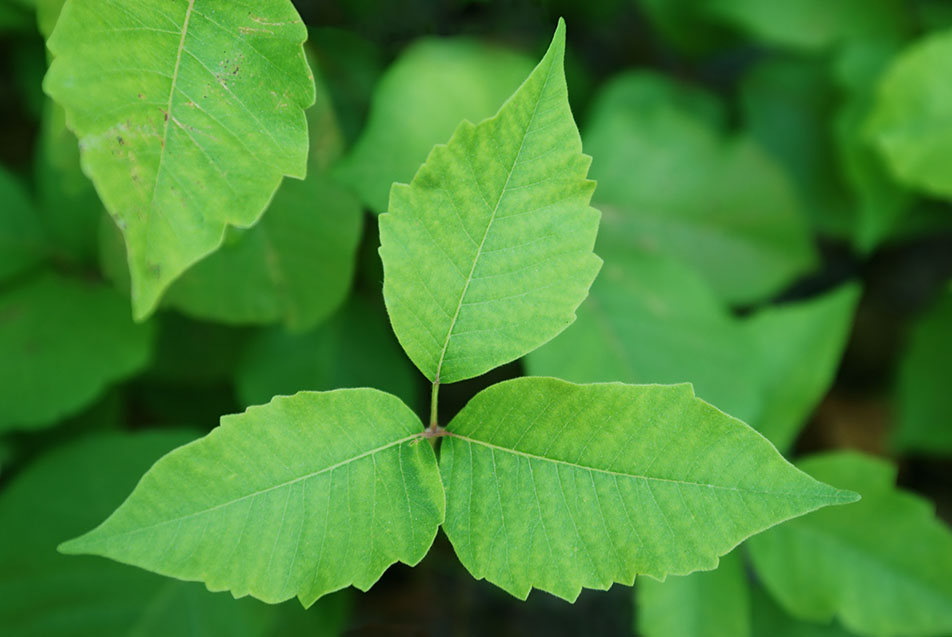
As we lace up our hiking boots to take to the local woods, or head out to tame our backyard landscaping, it’s important to be on alert for the greenery that could potentially cause harm and discomfort. We consulted resources from Purdue University, Indiana University and the Centers for Disease Control and Prevention to provide a basic guide for the most common culprits. It seems the old saying, “Leaves of three, quickly flee, berries white, poisonous sight," holds true.

Poison Ivy
Poison Ivy has slightly shiny, dark green leaves, which are usually found in groups of 3 and can be smooth or notched. In the fall they turn red. The plant most commonly grows as a vine, but can also be found as a low-growing shrub.
What you need to know about poison ivy:
• Immediately wash the exposed areas of skin with mild soap and running water. If you are in the woods, wash thoroughly in a running stream.
• Clothing that has been exposed to these plants should be laundered several times before wearing again.
• Gardening tools, sporting equipment and pets can also be sources of contamination.
• Avoid burning these plants - breathing in the fumes can cause toxicity.
• The fluid from blisters is not contagious.
• Avoid scratching, which can lead to infection.
• Corticosteroids, such as hydrocortisone cream, can be used to relieve symptoms, but should be used with caution in children.
• Antihistamines should be either taken by mouth or rubbed on the skin but not by both routes at the same time.
• Soap-less showers several times daily will help provide relief.
• The resulting rash can take up to 48 hours to appear and may last 2-3 weeks.

Poison Sumac
While it’s unlikely you will come into contact with sumac in Indiana, it can be found in swampy, boggy areas and has yellowish flowers that mature into clusters of glossy yellow or off-white berries. The sumac found along the roadside and as ornamental plants is not poisonous. Treat with cold compress, calamine lotion, hydrocortisone cream and an antihistamine to combat itching.
Poison Hemlock
This plant looks like a wild carrot or giant parsley, with stout, smooth stems with distinctive purple spotting, and small, white flowers in umbrella-shaped clusters. It is toxic when ingested and contains highly poisonous alkaloid compounds. It typically grows along roads, streams, trails, ditches, forest edges and waste areas.
Stinging Nettle
Stinging nettle is a common sight in the woods, on the banks of rivers and in waste areas in Indiana. Touching stinging nettle can produce itching and welts. The plant is armed with small hairs that, when touched, can inject a cocktail of histamine, serotonin, acetylcholine and formic acid11. Histamine causes an immune reaction in the body, while serotonin and acetylcholine are neural transmitters. Formic acid is the same compound we see in bee stings and fire ant bites. Stinging nettle often grows in patches and can become quite tall, growing up to 5 feet, but most likely 2 to 3 feet in height. Its stems are unbranched and leaves are opposite, egg shaped and with serrated margins. You can identify this plant by the stinging hairs on the stem.
Poison Oak
Contrary to common belief, this plant is not found in Indiana.
5 tips for protection
1. When hiking or working in a wooded area, wear protective clothing, including long sleeves, pants, gloves and hats
2. Wash skin and clothes after hiking or working in wooded areas.
3. Avoid burning any plants that you suspect could be poisonous. They are toxic in this state as well.
4. Educate small children or fellow hikers about poisonous plants.
5. Clean any walking poles or gardening tools with rubbing alcohol before putting away.